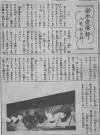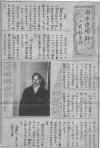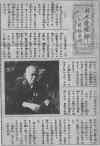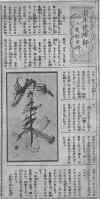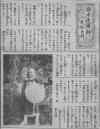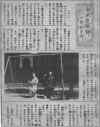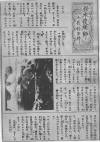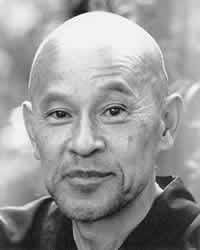 cuke.com
- an archival site on the life and world of Shunryu Suzuki and those who knew
him.
cuke.com
- an archival site on the life and world of Shunryu Suzuki and those who knew
him.
check home for more links what's new bibliography interviews stories excerpts/articles digressions and current events Zen Aluminati links Library of Tibetan Arts & Works comments and more if you look around
|
A Series on Shunryu Suzuki from the Hokubei Mainichi Shinbun written in 1972 by Rev. Ogui Koshin, now (2006) the Bishop of the Buddhist Churches of America Translated in 1993 by Kyoko Furuhashi and quickly edited by David Chadwick (in Feb. 2006) who made some changes where the facts were off – like saying that Suzuki was buried at Colma cemetery and that Baker practiced at Eiheiji for three years. This is just a working translation for now. - DC See the original articles in Japanese Interviews by DC with Rev. Ogui note: Gordon Geist wrote the following: I was puzzled by the reference to Dai Bosatsu Zendo in your recent posting "A Series on Shunryu Suzuki from the Hokubei Mainichi Shinbun". Dai Bosatsu Zendo is in New York -- Eido Roshi's temple. I thought Page street was called Beginners Mind Temple. I called Mel Weitsman in Berkeley and he reminded me that Shunryu Suzuki had originally named the building Dai Bosatsu Temple or the zendo, Dai Bosatsu Zendo [I guess I need to check on that exactly] and that Richard Baker changed it to Beginner's Mind Temple. - DC
English must have been a great barrier for you who left for the States at the age of 55 in May, 1959. You must have felt special affection for the dictionary which was a silent helper for you who trained the Japanese Americans as well as the Caucasians in spite of your age. This was written in January of last year, a little less than a year before you died. You seemed to have known your own death even at that time. Your compassion even toward a small dictionary seems to illustrate what you were. Mrs. Suzuki told me, "When he goes to the grocery store, he gets daikon that is not fresh, and when he buys charcoal, he gets the broken ones". She has also told me the story about the frogs that you had chased away before your schoolmates could arrive and catch them. We could sense the compassion that you held towards all living creatures.
You spoke little and gave a chance for them to realize things for themselves. I heard that there were some students who cried during the private training of dokusan. The balance of compassion and dignity reminded me of the heart of Nyorai. And this balance of compassion and wisdom coming from dignity resulted in training a successor, Richard Baker. I heard that Richard Baker was not satisfied with the professors of philosophy at Harvard University, and left the university to seek for a teacher. He was delighted when he met you in San Francisco. It had been more than eleven years from the time his training had started till your death.
I was told about the difficulty that you had gone through due to your illness at the time of kechimyaku no dempo which was to transmit to a recognized disciple from the succession of teachers. It seemed to have taken two hours for you as a sick person to do the dempo no shakyo. It must have been laborious work for you. Each word of the transmission that you were copying must have been significant. Even for Baker‑shi, who is a white, to do shakyo in Japanese must have been hard. [This is referring to Baker’s transmission ceremony in Japan] I was told that the shinsanshiki (Mt. Seat Ceremony) which started at 10:00am on Nov. 21 at Zen Center, and which was open to the public was truly dignified. After completing shinsanshiki in which Baker‑shi was designated as the formal abbot of Daibosatsu Zendo, you came back to your room, and seemed to look very tired. In that tiredness, you said, "What I needed to do in my life has been done", and you did gassho. What magnificent words they were to say as a human being. Once you mentioned to me, "It costs your life to create a successor." These words echo in my heart brightly and strongly.
I was told that there were tears of love for the teacher coming from deep sorrow, beyond words, of the over a hundred students in the zendo and over fifty students of Tassajara who were informed about your death. In spite of their tears, they sat with determination and completed five days of sesshin saying, "Nothing he has given us is greater than zazen."
Your mouth closed in a straight line showed your strictness, the smiling outline of your face showed your kind heartedness, and your quietly resting figure made people put their hands together in gassho saying, "like a statue of Buddha." During these six days of your body being enshrined, the students took turns in keeping guard from nine in the mornings to nine in the evening. Your body was placed in the front of the room, and six students at a time silently sat in zazen, three facing to the one side of the wall, and other three to the other side of the wall of the room. At the entrance of the room, two or sometimes four Caucasian Zen monks welcomed in gassho the guests who came to say farewell. I could not find any words to greet your students who were doing zazen withholding their tears in sorrow, doing gassho. Greetings with gassho without words touched our heart strings and created beautiful music like the sound of a wind‑bell on a rainy day. How great gassho is! In front of the coffin, the words "Nyorai Gassho" that you wrote with the dead leaves of trees of Tassajara, was placed. The fragrance of incense filled the room. The fragrance of the words "Nyorai Gassho" imprinted so deeply into my heart that it has never gone away.
In the midst of the sorrow, the sound of the chanting filled the Zendo, the corridor, the yard and the streets. It was a surprise for the Japanese‑Americans when they saw that the white and the dark sat and chanted together regardless the differences of their races. In the Japanese-American society, there was a tendency to become neurotic about defining the Japanese ways or American ways, or English or Japanese, etc. Here, people were living in what they believe, they were confident and unshakable in their lives in the tradition of Buddhism. It was a valuable opportunity to see this. I closed my eyes, feeling the nature of dharma, and did gassho in chanting. When I was outside in the courtyard, I saw a young Caucasian female doing gassho in the rain. I could not see her clearly but I could see her moving her mouth. She was in tune with the chanting coming from the zendo.
The ceremony was conducted by Sotoshu Kan‑in, Tanba(?) [Niwa] Roshi, Moriyama‑shi, and Katagiri‑shi who had worked as your right hand. Baker‑shi has now completed tokudo for 20 students, led the students to place your remains, and delivered a talk: "In the evening of one day before roshi had passed away, I went to see him and asked where would we meet next time? He reached his small hand out of the sheet, drew a circle in the air and smiled." You seemed to have taught them with strictness and gentleness till the end. Your words, "Without risking your life, you cannot create a successor" came to my mind. If I put it in a modern language, it will be "nikui" (difficult to do). Out of many mourners, the stillness of a devout woman in gassho was impressive and caught my heart.
You should not have forgotten your wife. You were lucky that she did not divorce you. The funeral started at ten and went on till after twelve as the line of mourners continued. And the next morning at 9:30 on Dec. 13, leaving Martin Brown Funeral Service, your body was cremated in the presence of your students. "Seeing the sorrowful tears of the students, I could not stop crying. " said Mrs. Suzuki. Looking at the students in sorrow, the words spoken by Shakusan were remembered: "Those who see themselves don't see themselves. Those who see dharma see themselves. Let the dharma be your light. Do not rely on others. Let the dharma be your master and live accordingly."
Dai Bosatsu Zendo has been established on Page Street in San Francisco. There is Zenshin‑ji Tassajara in the mountains of Monterey County where you can see clouds down below. There seem to be over 2,000 people practicing Zen, some of whom are professors of universities, students, business people and housewives. Baker‑shi in Dai Bosatsu Zendo, Katagiri‑shi in Zenshin‑ji, and Moriyama‑shi in the Japanese‑American temple, Sokoji, are doing their best to follow your spirit.
Your 49 day memorial ceremony was also completed on Jan. 21. The construction of the kaisando (founder’s hall), where your ashes will be put in rest is about to be finished. It is the expression of your students’ yearning for you. The light of the kaisando will forever shine upon the suffering of humankind and illuminate our minds as the light of dharma. Acknowledgment: I am thankful from my heart to: Hokubei Mainichi Shinbun which supplied the space for this column over 12 issues, Mrs. Suzuki and Mrs. Kaino(?) who contributed materials for the articles, Mr. Noguchi who donated the photos, the President (of Hokubei) Mr. Shimizu who wrote the titles, Mr. Yoshitsugu who made the layout. Gassho. |

